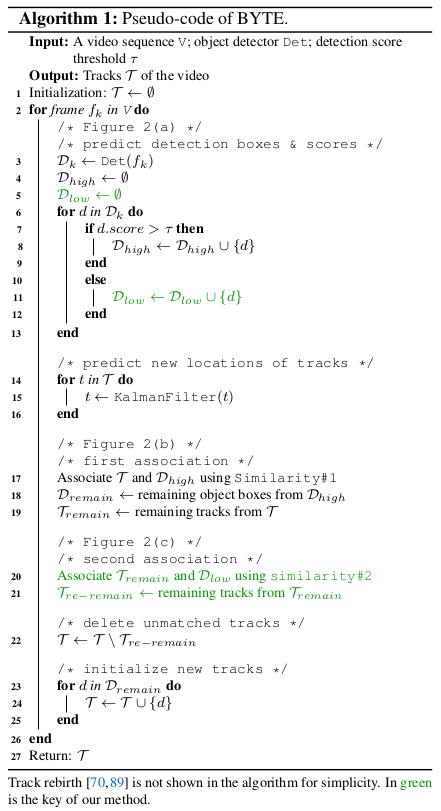Introduction
Following are my notes on BYTE, simple and effective association method. Proposed in paper ByteTrack: Multi-Object Tracking by Associating Every Detection Box.
BYTE, The Algo?

- For each frame in the video, we predict the detection boxes and scores using the detector Det.
- We separate all the detection boxes Dboxes into two parts Dhigh and Dlow according to the detection score threshold τ.
- detection boxes, Dboxes > τ stored into Dhigh
- detection boxes, Dboxes < τ stored into Dlow
- Use Kalman Filter to predict new location in current frame for each track in T;
- First association is performed between Dhigh and all the tracks T (including the lost tracks Tlost ) using
Similarity #1. Similarity #1can be computed either by the IoU or the Re-ID feature distances between the Dhigh and the predicted box of tracks T.- Next, we adopt Hungarian Algorithm to finish the matching based on the similarity.
- We keep the unmatched detections in Dremain and the unmatched tracks in Tremain.
- Second association is performed between the low score detection boxes Dlow and the remaining tracks Tremain after the first association.
- We keep the unmatched tracks in Tre-remain and just delete all the unmatched low score detection boxes, since we view them as background.
- We find it important to use IoU alone as the
Similarity #2in the second association because the low score detection boxes usually contains severe occlusion or motion blur and appearance features are not reliable. - For the unmatched tracks Tre-remain after the second association, we put them into Tlost.
- For each track in Tlost , only when it exists for more than a certain number of frames, i.e. 30, we delete it from the tracks T . Otherwise, we remain the lost tracks Tlost in T.
- Finally, we initialize new tracks from the unmatched high score detection boxes Dremain after the first association.
- The output of each individual frame is the bounding boxes and identities of the tracks T in the current frame.